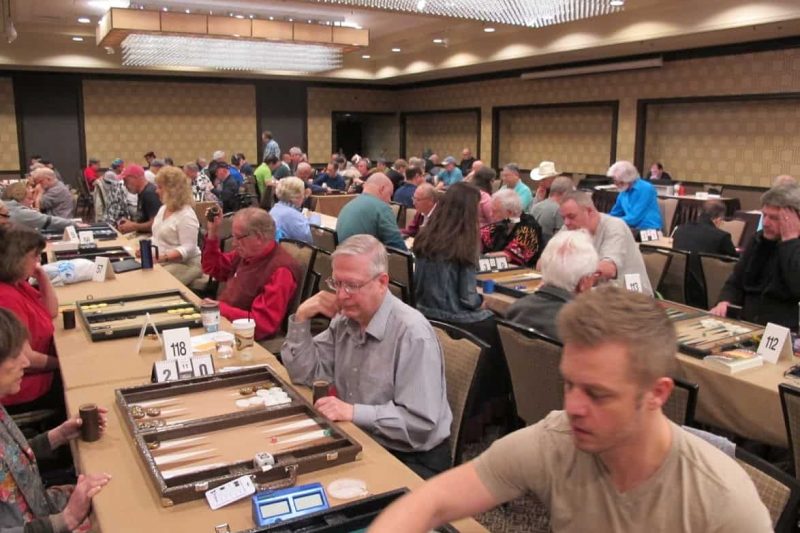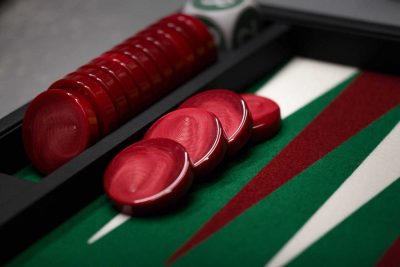The American Backgammon Tour (ABT) offers a dazzling variety of multi-day tournaments. Players travel from all over the U.S., and the world, to compete for ABT points.
While we take our competition seriously, these events are also fun and highly social. The backgammon community, in general, is quite friendly, and we are always happy to see a new face. You may want to start by attending the tournament closest to you and venture out to another once you are comfortable.
You can find the complete list of upcoming ABT tournaments and information on our calendar page. Each stop on the ABT tour has unique features designed to attract players and a wide variety of events. The nature and timing of these choices can sometimes be bewildering for a newcomer. This guide is designed to give you an overview and a general lay of the land.
As you read, it may be helpful to have the tournament brochure or website in front of you. Individual tournaments may have variations on the basic formats described here. Still, the following explanations should help you make sense of any of them.
ABT tournaments offer enrichment experiences beyond the excitement of the competition itself.
Entering the Main ABT Event
The core of any ABT tournament is the main event in which almost everyone participates. Players are paired up randomly into the main bracket. Throughout the weekend, they make their way through the event, competing for the championship title. If you lose, do not fret, there is a consolation bracket, and sometimes even a so-called last-chance draw offering a third chance to win a prize. Some ABT tournaments run a double-elimination format complete with a fighters bracket, where a player with one loss can come back and win the championship prize. Others employ a Swiss-style format that operates somewhat differently, but the gist is the same.
Your first task is to determine your appropriate level of play. The director of the event can help if you are unsure.
Terminology varies among ABT events, but there are three or four levels of play:
- Open / Championship – This is the top level. The term Open means that anyone willing to pay the entry fee is welcome to play. In contrast, top-level players are not permitted to play in lower divisions, which are limited to players of lesser expertise in the interest of fair competition.
- Advanced / Intermediate – This is the middle category. Players in this grouping are typically at ease with backgammon fundamentals, including using the doubling cube. They may even be experts in some areas of the game yet have not put together the necessary depth of comprehensive knowledge — or record of tournament success — that would require their promotion to the Open level. In some larger tournaments, Advanced and Intermediate are separate divisions.
- Novice / Beginner / Newcomer – This is the least experienced category. Players typically understand regular backgammon play but may be new to using the doubling cube or keeping score in match play. Tournament directors generally try to provide pleasant learning and playing experiences for novices. Depending on attendance, this may take the form of a Round Robin or similar contest.
Take careful note of Registration Deadline & Starting Times
The Open, Advanced, and Novice events at multi-day tournaments usually start at different times — and even on different DAYS. And unlike smaller local club events, you cannot expect to show up a half-hour before the draw is posted and be included. The registration deadline often is one day prior — so make sure to read your ABT brochure or consult the website carefully to avoid missing out.
Jackpot Events: Super / Masters / Limited / Novice
Jackpots are another staple in ABT tournaments. Jackpot events are single-elimination contests with no consolation. A Super Jackpot is for elite masters and high-rollers willing to pony up a substantial fee, often in the neighborhood of $1,000 or more. The Masters Jackpot is aimed at the very best players. In contrast, a Limited Jackpot typically mixes lesser-skilled Open players with Advanced and Intermediate players. Because the skill level in a Limited Jackpot is usually still relatively high, some tournaments offer specific jackpots designated for Advanced, Intermediate, and Novice players.
Entry for jackpots is usually done in advance, but you can also sign up on site if there are openings. Re-entries are typically permitted if you should lose in an early round and slots remain open. If you want to be sure of getting into a Jackpot, you may need to arrive a day or two earlier than for the main event. If you are in doubt, it is a good idea to contact the tournament director for advice.
Doubles – Play with a Partner
Doubles events are pretty popular. They are a fun way to experience competition, as you can learn a lot by consulting with a partner and paying attention to your opponents’ discussion. Any two people of any experience level can form a team and participate, which typically begins on a Thursday or Friday evening. Clocks are always required to keep a reasonable limit on the amount of conversation between teammates.
Mixed Skill Level: Seniors / Juniors / Speedgammon / Blitzes / Quickies etc.
Side events can be entered on a rolling basis whenever you have spare time and interest. You can generally re-enter these events any number of times throughout the tournament weekend. Entries will be cut off at some point when it’s judged that there isn’t enough time remaining to fill further draw sheets. Unlike the main ABT and jackpot events, these are mixed-ability contests, so you could wind up playing one of your backgammon heroes if — you have any. Since matches are usually shorter, a less-experienced player has a better chance than they might in a longer match. A special note about Seniors’ events: The definition of Senior can vary widely among ABT tournaments — and may even change from one year to the next — so double-check every time!
Time Commitments — Managing your Tournament Time
With all of the many events going on, the tournament director needs to keep all the brackets moving forward. Hence, participants who are still “alive” need to be available to play virtually any time. There are scheduled 2- to 3-hour breaks for dinner that allow players to escape to town for some local color. Still, rare circumstances require players to play into a break, or late into the evening, or early Sunday morning. Usually, this will only happen if you are in several events and there has been a logjam of some kind.
On the other hand, there can also be long gaps in play if you win a couple of quick matches and another part of the draw is slow. This is a great time to check out the side events so you can fill up the gaps in your day with more backgammon. But you can also take the opportunity to watch matches, have a drink, or read a book if you like.
When making travel plans, many players like to tack extra days on one end or the other of the tournament to see local sights, enjoy the atmosphere, or just rest up before playing. While participants are not required to stay at the tournament hotel, they are encouraged to do so. To secure the playing room at a reasonable rate Tournament organizers rely on filling guest room blocks — and it’s awfully nice to be able to retreat to your room to rest between matches.
Tournament Etiquette
One of the highlights of attending a tournament is the chance to observe many skilled players in action. Watching is usually allowed, but please take care to not make noise or cause a distraction. Spectators are not allowed to make any comments on a match in progress. Sometimes onlookers are tempted to point out an illegal play. However, if you observe an error, the right thing to do is alert the director, not the players. Some tournaments put matches on a video stream that players can watch in a separate room or on their own devices.
In your own matches, be aware that some players enjoy a bit of chitchat and others appreciate silence. Try to gauge your opponent’s tolerance level, and feel free to request a quiet match.
Overall, be a good sport. Play fair, be polite when you win, accept defeat with dignity, and show friendliness regardless of the outcome. Minor differences with other players, such as which board to play on, can be resolved via a dice roll. However, if there is a dispute during your match, don’t try to work it out yourself. Instead, stop the clock, if using one, and call the tournament director. That is what they are there for.
What About Clocks?
You’ll note that some events require the use of clocks, and many other events are Clock Preferred, which means that if your opponent wants to play with a clock, you’re playing with a clock. Don’t be intimidated! It typically takes just one game to get used to the back and forth flow of clock play. To end your turn, it’s just a matter of tapping the clock rather than picking up the dice.
As for running out of time, so long as you have reached a comfort level where you don’t need to count out your potential plays 1-2-3-4 every time you roll the dice, you should find the standard time controls quite comfortable. The way it works in many tournaments is that when your opponent taps their clock, you have, depending on skill level, somewhere between 12 and 15 seconds, to pick up the dice, roll, make a legal play, and tap the clock. That’s actually quite a bit of time for most plays. When you do happen upon a difficult play, you may take additional time from your time bank, which will begin to count down after your 12 seconds are up. You start the match with a bank of 2 minutes per point of match length, so if you’re playing to 9 points, you get 18 minutes of bank time for the whole match in addition to your 12 seconds per play.
You need to keep an eye on your bank, but it’s actually very unusual for most players to get into time trouble. And playing with a clock is actually to your advantage if you are playing a highly skilled opponent capable of doing a lot of mental calculations that require a lot of time.
One Pair of Dice
It is by now virtually universal that players are required to use a single pair of dice rather than two pairs for all events at ABT tournaments. If you are not using a clock, you will be tapping the frame of the board to signal you have completed your play.
The main benefit to this newish approach is that it eliminates disputes over what was rolled. The dice are not disturbed until your opponent picks them up, signaling their agreement that you made a legal play. This takes a little getting used to — but most players adapt fast.
Dice on Checkers
A few years ago, the USBGF encouraged a new tradition of allowing dice that land on checkers to stand rather than requiring a re-roll. It is an optional rule, that some ABT tournaments have adopted. In contrast, others stick to the traditional rule where dice must land on the playing field to be considered legal.
In either case, dice that land cocked — or where it is unclear what the roll is — must be re-rolled.
Legal Moves
There has been a movement in the 21st century toward requiring illegal plays to be reversed and played legally. So you must be aware of the standard for any backgammon tournament you are attending.
Under Legal Moves, if you note an illegal play, you are obligated to bring it to your opponent’s attention and require that it be played legally. This is true even if that correction is not to your advantage — it’s a matter of personal honor and sportsmanship!
At a non-Legal Moves tournament, sometimes called Responsible Moves, players may, by mutual consent, play legal moves anyway. But absent such an agreement, you may be held to egregious goofs like placing your own checker on the bar.
Bringing Equipment
You aren’t required to bring any equipment to tournaments, but if no one did, we’d have a big problem! So bring what you’ve got. Some players like baffle boxes, also known as dice tumblers, instead of cups, and it’s okay for one player to use a cup and the other to use a baffle box. Some people want to use a cup and a baffle box.
A Rich Experience
ABT tournaments offer enrichment experiences beyond the excitement of the competition itself. You’ll find the tournament room a veritable showroom of backgammon equipment produced all over the world, including unique custom-built sets that you’d want to see in person before purchasing.
There are often boards and books available for purchase, as well. The best ABT tournaments offer learning opportunities, including a backgammon lecture or instructive quiz, as well as ongoing opportunities to watch streaming matches with live commentary in a nearby area. Maybe best of all, you can make the acquaintance of and perhaps play across from some of the top backgammon players in the world.




